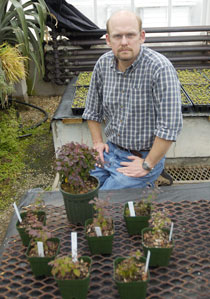Researchers Outsmarting Popular
But Invasive Barberry Shrub
 |
| Mark Brand (pictured), professor of plant science, and Yi Li, an associate professor of plant science, are researching the Japanese barberry. |
|
Photo by Melissa Arbo |
Two researchers who head the University’s Plant Biotechnology Facility are working to keep the ornamental shrub Japanese barberry available to gardeners and landscapers, while protecting the environment from its uncontrolled spread.
Mark Brand, a professor of plant science, and Yi Li, an associate professor of plant science, are experimenting with two different approaches to developing a sterile form of the plant that would have its desirable features, without producing seeds.
Japanese barberry, introduced to the United States from Asia in the 1800s, is highly popular among homeowners and landscapers – annual sales of the shrub are estimated to be $15 million to $20 million in Connecticut alone – but is considered invasive. It was included on the state’s list of invasive plants last year, and professionals in the nursery industry fear it may be banned in the future.
“Japanese barberry is a very important ornamental not only in Connecticut, but all across the northern U.S.,” Brand says. “It is deer-resistant, and is tolerant in a number of different conditions or places, from homeowners’ yards to parking lots.”
But for the same reason the shrub is such a popular choice for landscapers – it establishes easily and grows aggressively – it can create havoc in the environment, says Li.
Japanese barberry and other invasive plants disperse over wide areas, sometimes displacing and overtaking native species and reducing biological diversity, with significant environmental consequences.
Brand, who displayed posters about his research on Capitol Hill in Washington, D.C., earlier this month as part of Agriculture Education Week, is pursuing traditional breeding techniques to create a Japanese barberry plant with three complete sets of chromosomes.
Offspring with an uneven number of chromosomes would be sterile, because an uneven number of chromosomes interferes with seed and pollen development, he explains.
Brand’s work involves first creating a tetraploid Japanese barberry, or one that has four complete sets of chromosomes, and then breeding it with the original diploid plant, to create the sterile triploid. To do this, Brand uses the chemicals colchicine and oryzalin as mutagenic agents to interrupt normal cell division in tissue culture, so the chromosomes do not separate. The tetraploid cells are then grown into shoots in tissue culture, rooted, acclimated in a greenhouse, and grown into flowering plants.
As part of his research, Brand also is developing DNA fingerprints for garden cultivars of Japanese barberry.
There are two kinds of Japanese barberry – a wild green variety that grows to between four and six feet tall, and the garden cultivars with attractive, colorful leaves that come full-sized and as smaller, “dwarf” shrubs. Brand is seeking to determine whether invasive populations of the plant originated from the wild barberry or the ornamental variety.
Brand also is measuring the reproductive potential of the fruit from the garden cultivars.
“There are definitely differences in the amount of fruit that different cultivated forms of the plant produce,” Brand says. “Environmentalists would say any fruit is bad. My goal is to generate the data, not to determine which plants should be banned.”
Li is using his own patented “seedless fruit technology” to develop sterile Japanese barberry, as well as a sterile version of winged euonymus, or burning bush, as it is more commonly known.
“We have already demonstrated that the seedless technology works beautifully in tomatoes and watermelons,” Li says.
To develop his seedless fruit technology and the “super-sterile” technology (a seedless fruit gene plus male and female sterile genes) that he is using for Japanese barberry and burning bush, Li used recombinant DNA technology. With the recombinant DNA technology, he isolates DNA from plants or other organisms, cuts them into fragments, and then “glues” the fragments together in test tubes to create the new genes. Then he introduces the new genes made in test tubes into the targeted plants or cultivars, resulting in transgenic plants.
Li has created the super-sterile gene needed for Japanese barberry and burning bush and perhaps other popular, but invasive, shrubs. The challenge now, he says, is to introduce the gene into the plant cell and grow an entire plant from a single transformed cell.
The researchers say each approach has its own strengths and weaknesses.
A sterile Japanese barberry produced by Brand’s method might not have the characteristic red berries. Li’s would. But Brand’s sterile barberry would likely stir less cause for concern and have fewer regulatory hurdles to clear, because, unlike Li’s, it would not be transgenic.
“Either way, this is not going to happen overnight,” Brand says.
The researchers estimate it could take several years to produce a plant they can say with certainty is sterile, and even longer before it would be ready for introduction to the marketplace. But they are likely to have many interested parties monitoring their progress in the meantime.
With Japanese barberry sales robust throughout the northeast region and midwestern states, says Brand, “this could be one of the University’s most significant patents.”

